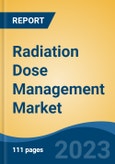Speak directly to the analyst to clarify any post sales queries you may have.
10% Free customizationThis report comes with 10% free customization, enabling you to add data that meets your specific business needs.
Growing Concern about Radiation Dose Exposure
Over the last two decades, the usage of radiation exposure to patients has increased significantly. This can be attributed to the increasing usage of radiation in diagnostic test like CT scans, fluoroscopy, and interventional imaging procedures is expected to create lucrative growth during the forecast period. Similarly, increasing the risk of radiation overexposure for obese patients is high, so for the diagnosis of the obese patient, higher tube currents are basically used for better image quality. According to the society of nuclear medicine, around 20 million nuclear medicine procedures are performed every year in the U.S. It is estimated that 197,700 new cases of melanoma, 97,920 non-invasive (in situ), and 99,780 invasives, will be diagnosed in the U.S. in 2022.The Growing Incidence of Cancer is Driving the Growth
The increasing prevalence of cancer is expected to create lucrative growth during the forecast period. Due to alcohol consumption, excessive smoking, and unhealthy lifestyles, cancer is increasing rapidly across the globe. Similarly, growing aging populations are more susceptible to chronic diseases, which in turn boosts the market growth over the years. Cancer is the second leading cause of death across the world. Its approximate death rate was 9.6 million in 2018. According to GLOBOCAN, in 2012, 14.1 million new cancer cases were diagnosed across the world, which increased by 28% to reach 18.1 million new cases in 2018. In the future, treatment costs will increase because of the growing aging population along with the prevalence of different types of cancers.Rising Demand for Minimally Invasive Procedures
The increasing demand for minimally invasive surgeries has contributed to the significant growth of Global radiation dose management market during the forecast period. Similarly, the growing demand for shorter hospitalization, less pain, smaller and more cosmetic incisions, lower risk of infection, reduced post-operative care, and quicker recovery is expected to create lucrative growth during the forecast period. It uses advanced technology to diagnose and treat different chronic diseases, including cancer. It also helps surgeons make an appropriate cancer treatment plan. The rapid adoption of new technology can enhance the demand for the interventional oncology devices market across the globe. Nearly 20 Americans die from melanoma every day. In 2022, it was estimated that 7,650 deaths will be attributed to melanoma - 5,080 men and 2,570 women
Market Segmentation
The global radiation dose management market can be segmented by product, component, application, and region. Based on the product, the market can be divided into Dosimeters and Area Process Monitors. Based on components, the market can be grouped into Software and Services. Based on application, the market can be segmented into Radiography, Angiography, Mammography, Fluoroscopy & Interventional Imaging. Regionally, North America dominates the market among Asia Pacific, Europe, Middle East & Africa, and South America. Among the different countries, the United States dominates the global radiation dose management market on account of the growing demand for minimally invasive surgeries with low costs for the treatment of chronic diseases like cancer across the country.Recent Development
- The ControlRad device, approved for commercial cath lab use by the FDA in December 2020, is retrofitted to X-ray equipment in the catheterization lab. It creates a type of aperture that collimates the image area being viewed. By using a touchpad attached to the table side rail, the cardiologist controls the aperture to narrow or widen the field of view on the X-ray, reducing the amount of radiation used to produce the images. It works with gloves on.
- April 2021 - The American College of Radiology has launched a new digital radiography pilot program to standardize radiation dose variation in chest exams in order to track and compare radiation dose patterns across healthcare practices using digital radiography.
Market Players
Bayer AG., General Electric Company, Koninklijke Philips N.V., Siemens Healthcare GmbH, FUJIFILM Holdings Corporation, Sectra AB, Medic Vision Imaging Solutions, Agfa-Gevaert Group, Novarad Enterprise Healthcare Solutions, Guerbet are some of the leading players operating in the global radiation dose management market.Report Scope:
In this report, the global radiation dose management market has been segmented into the following categories, in addition to the industry trends, which have also been detailed below:Radiation Dose Management Market, By Product:
- Dosimeters
- Area Process Monitors
Radiation Dose Management Market, By Component:
- Software
- Service
Radiation Dose Management Market, By Application:
- Radiography
- Angiography
- Mammography
- Fluoroscopy & Interventional Imaging
Radiation Dose Management Market, By Region:
- North America
- United States
- Canada
- Mexico
- Europe
- France
- Germany
- United Kingdom
- Italy
- Spain
- Asia Pacific
- China
- India
- Japan
- South Korea
- Australia
- South America
- Brazil
- Argentina
- Colombia
- Middle East & Africa
- South Africa
- Saudi Arabia
- UAE
Competitive landscape
Company Profiles: Detailed analysis of the major companies present in the Global Radiation Dose Management Market.Available Customizations:
With the given market data, the publisher offers customizations according to a company’s specific needs.This product will be delivered within 1-3 business days.
Table of Contents
Companies Mentioned
- Bayer AG.
- General Electric Company
- Koninklijke Philips N.V.
- Siemens Healthcare GmbH
- FUJIFILM Holdings Corporation
- Sectra AB
- Medic Vision Imaging Solutions
- Agfa-Gevaert Group
- Novarad Enterprise Healthcare Solutions
- Guerbet








